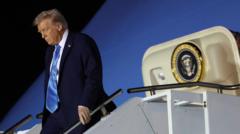In an extraordinary turn of events that unfolded over months of complex discussions, Israeli and Hamas negotiators sealed a historic ceasefire deal in Doha, Qatar, with only minutes to spare before a planned press conference. Although the two sides never met face-to-face, the frantic negotiations were conducted through mediators from Qatar, Egypt, and the United States, emphasizing the high stakes involved.
Historic Ceasefire Deal Achieved Just Before Deadline

Historic Ceasefire Deal Achieved Just Before Deadline
Amid a backdrop of intense negotiations, Israel and Hamas reached a landmark ceasefire agreement just moments before a scheduled announcement.
The groundwork for the agreement traces back to a framework initially outlined by President Joe Biden in May, setting a phase-based approach that includes a ceasefire, the release of hostages, and a withdrawal of Israeli forces from Gaza. Nevertheless, it was a series of power shifts in the Middle East that set the stage for the sudden acceleration in talks.
The pivotal moment arrived in mid-December, when the dynamics of negotiations started to change significantly as Hamas faced increased isolation following the killing of its leader, Yahya Sinwar. The deteriorating position of Hamas was viewed as pressing them to reconsider their negotiating strategy. Meanwhile, U.S. officials suggested that both the outgoing Biden and incoming Trump administrations contributed to the momentum, culminating in high-stakes discussions involving top diplomats from both sides.
The final 72 hours of negotiations became a race against time, characterized by proximity talks, where details flowed between the two parties through mediators, as they worked out the particulars of hostage exchanges and troop withdrawals. Crucial meetings took place with U.S. envoy Steve Witkoff playing a vital role in reinforcing the pressure on Israeli Prime Minister Benjamin Netanyahu to finalize the deal.
Despite objections and challengers from both sides during a marathon session that spanned days, the final agreement was eventually reached on 15 January, marking a significant breakthrough that underscored the complexities of Middle Eastern geopolitics, and offered a glimpse of hope for peace in the region.
The pivotal moment arrived in mid-December, when the dynamics of negotiations started to change significantly as Hamas faced increased isolation following the killing of its leader, Yahya Sinwar. The deteriorating position of Hamas was viewed as pressing them to reconsider their negotiating strategy. Meanwhile, U.S. officials suggested that both the outgoing Biden and incoming Trump administrations contributed to the momentum, culminating in high-stakes discussions involving top diplomats from both sides.
The final 72 hours of negotiations became a race against time, characterized by proximity talks, where details flowed between the two parties through mediators, as they worked out the particulars of hostage exchanges and troop withdrawals. Crucial meetings took place with U.S. envoy Steve Witkoff playing a vital role in reinforcing the pressure on Israeli Prime Minister Benjamin Netanyahu to finalize the deal.
Despite objections and challengers from both sides during a marathon session that spanned days, the final agreement was eventually reached on 15 January, marking a significant breakthrough that underscored the complexities of Middle Eastern geopolitics, and offered a glimpse of hope for peace in the region.























